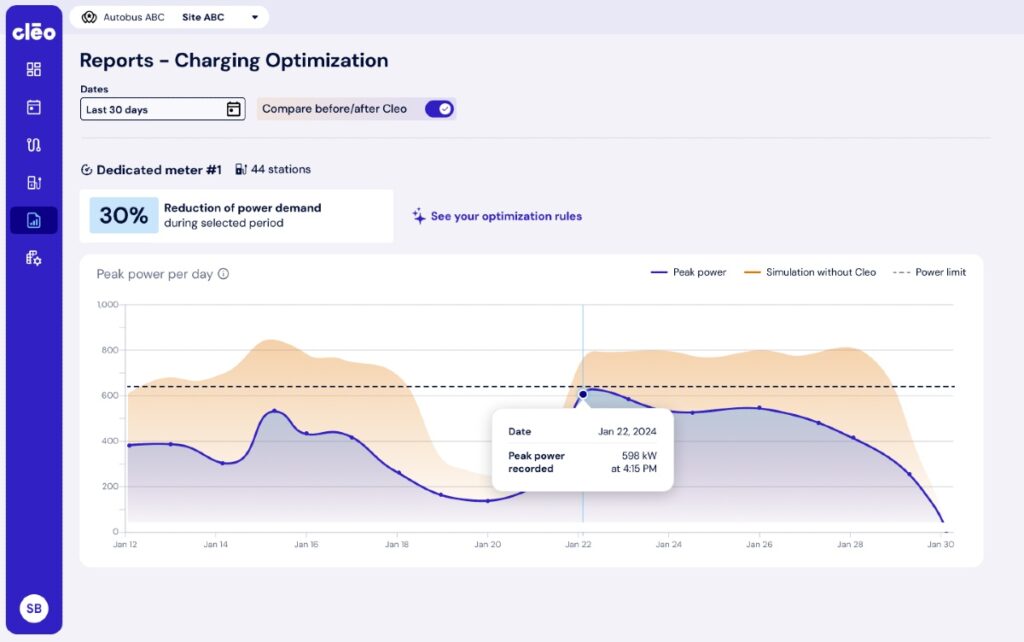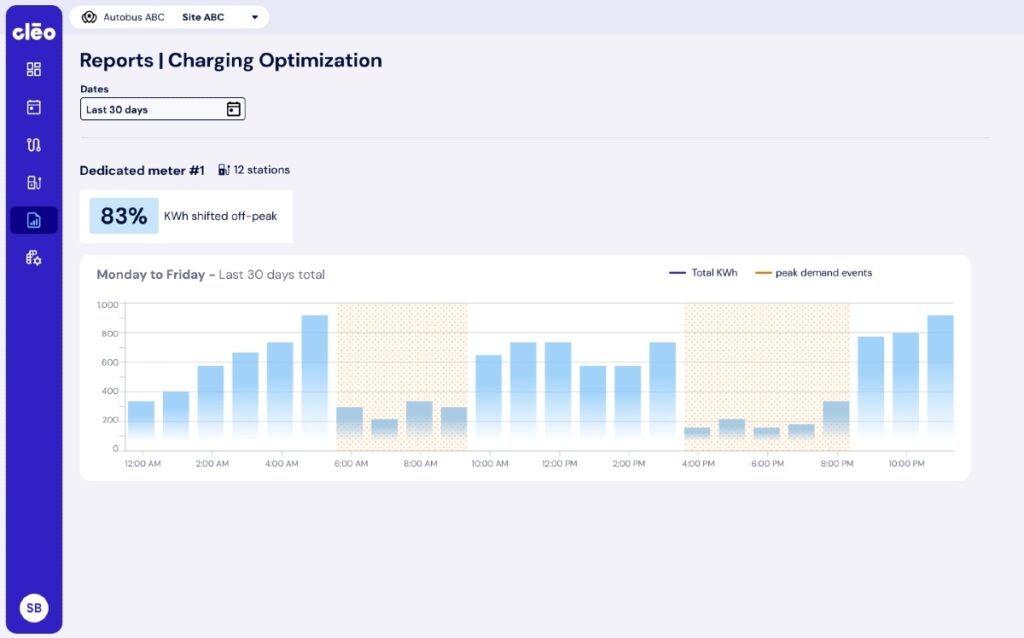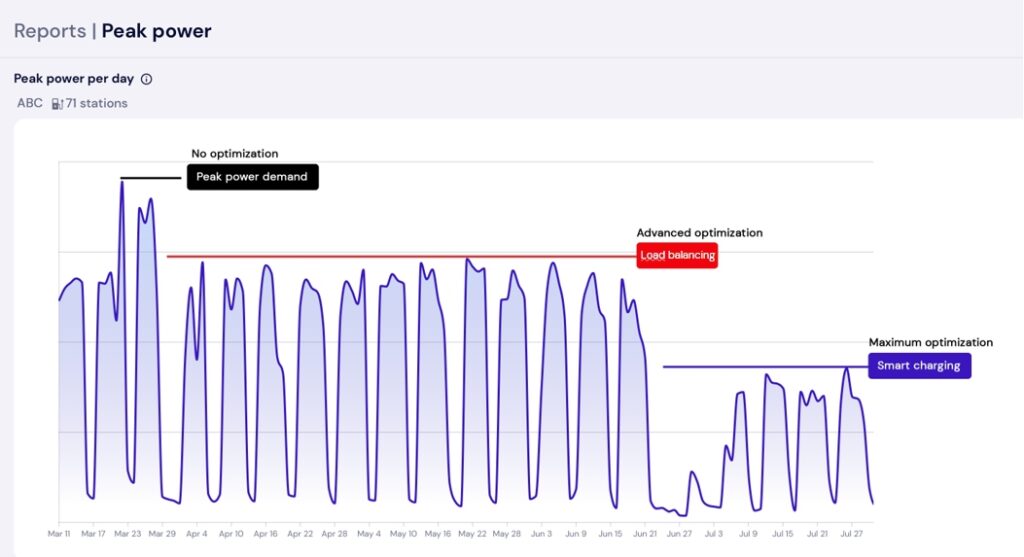How Smart Charging Helps Electric Fleets Work Smarter and Save Money
A charging station is hardware equipment that is designed to safely deliver electricity to a vehicle to supply it with the energy it needs to drive the next day. Smart charging software gives the fleet owner much more flexibility and control over how that electricity is delivered to the vehicles (as well as giving a bird’s eye view of the energy stored in each vehicle, or the state of charge). This is also known as managed charging or smart charging.

Why should fleets be interested in smart or managed charging?
- To charge electric vehicles in the least amount of time at the best possible cost, taking into account electricity rates to optimize the energy distribution.
- To avoid demand charges, where power is drawn in a way that spikes and triggers a higher electricity cost;
- To shift power demand to off-peak hours or to when electricity is cheaper to save on energy costs;
- To get a bird’s eye view of the chargers, vehicles and energy available in the system, as well as provide real-time data allowing them to adapt charging schedules to operational needs;
- To extend their EV’s battery life by avoiding overcharging and unnecessary charge cycles;
- To help monetize their electrification with return on investment programs (if applicable in their area). These could include compliance carbon credits and demand-response programs.
- To avoid the need for an electrical upgrade or to reduce the cost of an electrical upgrade by reducing or managing the kW delivered at any specific point in time.

“Using a smart charging platform not only helps you achieve your sustainability and operational goals, but it’s also a competitive advantage for your organization. It lowers your energy costs, enhances operational efficiency, and ensures optimal vehicle readiness for peak performance.”
— Stéphane Belair, VP Strategic Growth at Polara, for Cleo’s platform
Smart or intelligent charge management software reduces the peak power (or “electrical load”) being drawn to the EV charging stations at any given time, a practice called “peak shaving”.
Power versus energy
Energy is the amount of power stored in the battery and available to the driver to complete the route the next day. Power is the rate at which energy is drawn. If you think of a car battery as a bucket, energy is the amount of water needed to fill the bucket, and power is the volume and flow of the water into the bucket.
What does charge management software do?
- The software sends instructions to the chargers
Detailed commands initiate charging sessions at specific times and power levels, allowing for sequential versus parallel charging. This prevents all of the charge sessions from being started at the same time, as soon as vehicles are plugged in, at the full power available in the charger, such as at the end of a shift. Allowing for rolling charging over the course of a night, for instance, reduces the power drawn at any given time. Throttling down the power delivered to each vehicle at any given time is another strategy to reduce electricity costs (e.g. a 50kW DC fast charger may be throttled down to 20 kW by the software).

- Software determines the exact power needed by each vehicle
The software can calculate the real energy needs of the fleet vehicle – again, minimizing the overall power delivered. For instance, the software can evaluate the state of charge and compare it to the route to be driven the next day, optimally “topping up” the battery versus automatically charging to 100 percent. This can get very sophisticated, connecting into telematics and route dispatch software. Energy needs can even be calculated based on payload, route, weather, speed, even a buffer for unforeseen circumstances that would be very difficult to execute manually. In fact, some platforms are using AI to improve their predictions on daily energy needs, automatically learning routes and therefore relieving the operator of the day-to-day management of schedules and itineraries.
The best platforms can also prioritize which vehicle is being charged first, based on their time of departure. This can rely on the automatic recognition of vehicles at the charging stations. - Provides a bird’s-eye view of charging operations
The fleet operator’s dashboard view shows the state of charge of all the vehicles, whether they are plugged in or not, the power drawn, the current state of charge and any issues with the charging stations themselves. A smart platform can also send alerts and notifications to promptly address unforeseen charging interruptions, thus enhancing operational efficiency. Finally, with reports and analyses, operators can view their charging session history, and the detail of the power delivered to the vehicles on their site.
Full up on charging knowledge? Try the Lesson 4 quiz before tackling Lesson 5: The business-boosting power of a data-driven fleet.
Reproduction of any or all of this material is strictly prohibited without permission. Please contact fleets@electricautonomy.ca for inquiries. Copyright © 2025 – Electric Autonomy Canada – ArcAscent Inc. – All Rights Reserved
Want to learn more? Sign up or log in so you can track your progress, earn a course certificate and receive exclusive invitations to our live learning sessions.